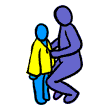|
|
- A- Nilh 'a'lu lhwet thu'i?
|
Who is this? |
|
|
It is the doctor. |
- A- Nilh 'a'lu lhwet tu'i?
|
Who is this? |
|
|
It is the helper. |
- A- Nilh 'a'lu lhwet tthey'?
|
Who is that? |
|
|
It is the speaker. |
|
Use lhwet to ask the question "who?". Using the particle 'a'lu with lhwet expresses the idea of "whoever". That is, the speaker is really curious and has no idea who the person is. Some people use lhwet by itself, but many people say nilh lhwet , which we use here.
| Nilh 'a'lu lhwet tu'i? |
"Who is this (male)?" |
| Nilh 'a'lu lhwet thu'i? |
"Who is this (female)?" |
| Nilh 'a'lu lhwet tthey'? |
"Who is that (male)?" |
| Nilh 'a'lu lhwet they'? |
"Who is that (female)?" |
Thu'i and they' are feminine forms, used if the person is female. We will return to gender in Lessons Five and Six.


